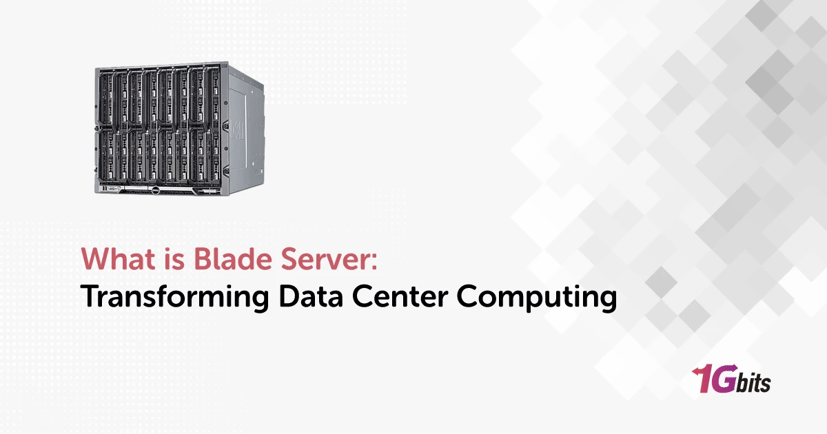These days, we see data center setups rapidly evolving. If you’re familiar with these setups, you’ve probably heard of blade servers as well. These servers have become essential, changing how companies handle their computing needs. But what is blade server, and how is it different from regular servers? In this detailed guide, we'll take a closer look at blade servers, covering their structure, uses, advantages, and what to consider when deploying them.
What is Blade Server?
A blade server is a specialized type of server that's designed to fit multiple thin, modular server units, known as server blades, into a single chassis. These server blades are like individual servers, each containing its own set of essential hardware components, including processors, memory, storage, and networking interfaces. The chassis acts as a centralized hub providing power, cooling, and connectivity for all the server blades it houses.
Blade servers are engineered to optimize space and energy usage while providing robust computing capabilities. They offer a streamlined approach to managing data center resources, making them an attractive option for organizations with high-density computing needs.
What is Blade Server in Networking?
In networking, a blade server plays a vital role in the infrastructure, serving as a central hub for managing and distributing data across a network. It acts as a connector between different network devices, applications, and systems, ensuring smooth communication and data transfer throughout the network.
For those of you asking what is a blade server system, blade servers streamline networking operations by centralizing computing resources and facilitating efficient data exchange between connected devices.
What is Blade Server Example?
To learn what is blade server better, let’s mention some examples. A typical example of a blade server is a blade chassis containing multiple blade modules. Each blade module houses essential hardware components such as CPU, memory, storage, and networking interfaces. Examples of blade server manufacturers include HPE BladeSystem, Dell PowerEdge M Series, and Cisco UCS Blade Servers.
Blade Server Architecture
The architecture of a blade server is built upon a modular design that prioritizes efficiency and scalability. It consists of several key components that work together seamlessly to provide robust computing capabilities. Let’s explore these components to understand what is blade server architecture:
Blade Server Chassis
So what is a blade server chassis? The blade server chassis serves as the housing for multiple blade modules. It provides shared power, cooling, and networking infrastructure, consolidating these resources into a single enclosure. This design optimizes space usage and simplifies infrastructure management.
Blade Modules
Blade modules are the heart of the blade server architecture. These thin computing units contain essential hardware components, including CPUs, memory, storage, and networking interfaces. They are designed to be hot-swappable, allowing for easy replacement and maintenance without disrupting the overall system operation.
Management Modules
Management modules are essential for remote monitoring and management of blade servers. They provide administrators with a centralized interface for monitoring server health, configuring settings, and troubleshooting issues. By enabling remote management capabilities, these modules ensure efficient operation and minimize downtime.
Blade Server vs Rack Server
Now that we've explored what is blade server, let's take a look at rack servers. Unlike blade servers, which are compact computing units housed within a shared enclosure, rack servers are standalone units that are typically mounted in standard server racks.
Rack servers are individual computing units that are installed in standard server racks. Each server operates independently and contains all the necessary components within its own chassis. Rack servers are typically larger in size compared to blade servers and require more physical space in a data center.
What is the Difference Between Blade Server and Rack Server:
For those of you still asking what is blade server and rack server, we’ve compared the two in different ways:
Density:
-
Blade servers offer higher density by packing multiple computing units into a single enclosure.
-
Rack servers, on the other hand, have lower density as each server occupies its own space within the rack.
Efficiency:
-
Blade servers share common resources such as power and cooling, leading to better energy utilization.
-
Rack servers operate individually, which may result in higher energy consumption compared to blade servers.
Scalability:
-
Blade servers are highly scalable, allowing for easy addition or removal of blade modules as needed.
-
Rack servers can be expanded by adding more individual servers to the rack, but it may require more space and cabling.
Management:
-
Blade servers offer centralized management interfaces, simplifying administration tasks.
-
Rack servers require distributed management as each server needs separate configuration and monitoring.
For more information on how different blade servers are from others, check our article about Different types of servers.
Types of Blade Servers
Blade servers are available in different configurations. To understand what is a blade server in information technology, let’s get familiar with its different types:
-
General-Purpose Blade Servers: These servers are versatile and well-suited for a wide range of applications. They offer a balanced combination of processing power, memory, and storage capacity, making them suitable for various computing tasks.
-
Virtualization-Optimized Blade Servers: Designed to host virtual machines efficiently, these servers are optimized for virtualization workloads. They typically feature enhanced memory and CPU resources to support multiple virtual machines simultaneously. Virtualization-optimized blade servers are ideal for organizations looking to maximize resource utilization.
-
High-Performance Computing (HPC) Blade Servers: Engineered for compute-intensive workloads, HPC blade servers are equipped with multiple CPUs and often support GPU accelerators. They are designed to handle complex computational tasks such as scientific simulations, data analytics, and rendering.
What is Blade Server Used For?
Blade servers find applications across diverse use cases. In this section, we’ll see what is blade server used for:
1. File Sharing: Blade servers facilitate the smooth transfer of data between digital devices or different points within a network, enabling efficient collaboration and file exchange.
2. Web Page Serving and Caching: They efficiently deliver web content to users and cache frequently accessed data, improving website performance and reducing load times. If you don’t know what is a web server?, check our article on this topic.
3. SSL Encryption: Blade servers ensure secure communication over the internet by encrypting data, safeguarding sensitive information from unauthorized access.
4. Transcoding: They convert website elements to ensure seamless display across different devices, enhancing user experience and accessibility.
5. Streaming: Blade servers transmit audio and video content in real-time, supporting streaming services and enabling users to access media without interruption.
6. Virtualization: Blade servers create virtual instances of applications, optimizing resource utilization and facilitating efficient management of computing resources.
7. Storage: They store large volumes of data to support multiple applications, providing reliable and scalable storage solutions for businesses.
8. Cluster Computing: Blade servers are used in cluster computing environments to ensure high availability, scalability, and load balancing, enhancing overall system performance and reliability.
Benefits of Blade Servers
Some of you ask what is blade server given its benefits. The advantages of blade servers over traditional architectures include:
1. High Density: Blade servers pack more computing power into a smaller footprint compared to traditional servers, maximizing space utilization in data centers and reducing the physical footprint.
2. Efficiency: They share common resources such as power supplies and cooling infrastructure, leading to reduced power consumption and better energy efficiency. This results in lower operational costs and a smaller environmental footprint.
3. Scalability: Blade servers are highly scalable, allowing organizations to easily add or remove blade modules to meet changing computing demands. This scalability ensures that the infrastructure can adapt to evolving business needs.
4. Simplified Management: Blade servers provide centralized management capabilities, allowing administrators to efficiently monitor and manage multiple servers from a single interface. This simplifies administration tasks and reduces management overhead.
5. Cost Savings: While the initial investment in blade infrastructure may be higher, the total cost of ownership (TCO) is often lower due to reduced power consumption, simplified management, and optimized space utilization. Organizations can achieve significant cost savings over the long term.
Tips for Choosing the Right Blade Server for Your Organization
Choosing the right blade server explained for your organization is crucial for maximizing performance, efficiency, and return on investment. Now that you know what is a blade server in computer, here are some tips to help you make an informed decision:
-
Assess Your Workload Requirements: Start by understanding your organization's workload requirements. Consider factors such as processing power, memory, storage, and networking needs. Determine whether your workload is compute-intensive, storage-heavy, or requires virtualization support.
-
Consider Scalability: Look for blade servers that offer scalability to accommodate future growth. Choose a solution that allows you to easily add or remove blade modules as needed, ensuring that your infrastructure can adapt to changing demands.
-
Evaluate Management Capabilities: Consider the management features offered by the blade server solution. Look for centralized management tools that provide visibility and control over all blade servers within the chassis. This will simplify administration tasks and streamline operations.
-
Review Networking and Storage Options: Assess the networking and storage connectivity options offered by the blade server. Ensure that it supports your organization's networking protocols and storage technologies. Look for integrated networking and storage options to streamline deployment and reduce complexity.
-
Check Compatibility and Interoperability: Ensure that the blade server solution is compatible with your existing infrastructure and software ecosystem. Consider interoperability with other hardware components, virtualization platforms, and management software.
-
Consider Power and Cooling Requirements: Evaluate the power and cooling requirements of the blade server solution. Choose a solution that offers energy-efficient components and effective cooling mechanisms to minimize operational costs and environmental impact.
Blade Server Price
Now that you know the blade server definition, you might think of buying these servers. Blade server prices vary based on factors such as configuration, vendor, and included features. Generally, blade servers may have a higher upfront cost compared to traditional servers due to their integrated design and scalability features. However, they offer long-term cost savings through energy efficiency and space optimization.
Final Words
Blade servers represent a significant evolution in data center computing, offering high density, efficiency, and scalability for modern IT environments. With their compact design, shared resources, and centralized management, blade servers address the growing demands of today's businesses for flexible and cost-effective computing solutions.
By understanding what is blade server in computer networking, its architecture, benefits, and considerations associated with blade servers, organizations can make informed decisions to optimize their infrastructure for performance and efficiency.






